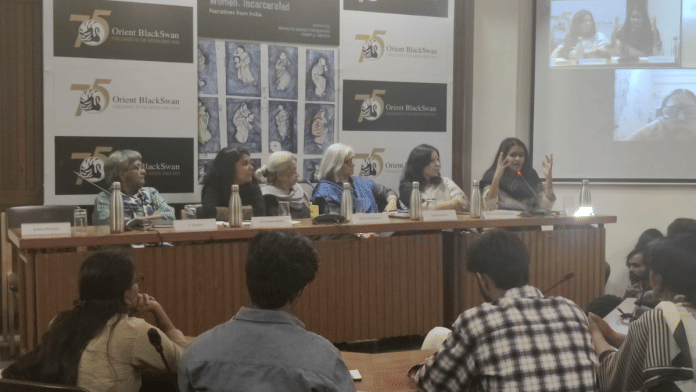The blindfold on the statue of Lady Justice should be removed so that justice can be delivered with the knowledge that every inmate is not the same. This argument was put forth not by a legal scholar but a female inmate at Tihar Jail to Pinjra Tod activist Devangana Kalita who was arrested under the stringent Unlawful Activities (Prevention) Act in 2020. Kalita shared it at the launch of the book Women, Incarcerated: Narratives from India, edited by Mahuya Bandyopadhyay and Rimple Mehta at Delhi’s India International Centre. Everybody in the packed venue—editors, the audience, and panellists—nodded knowingly.
The book not only examines the state of women’s jails in India but also looks at how women prisoners are viewed. Here, they are figures of curiosity and intrigue, cast as grotesque and demonic figures who transgressed the ‘Lakshman Rekha’ — the legal, normative, and moral boundaries of social life.
Revisiting her experiences while working on the project at Tihar Jail, Bandyopadhyay, associate professor at Delhi’s Indian Institute of Technology (IIT), shared how challenging it was to conduct research because of the surveillance system in place. The volume pierces through the lived experiences of women prisoners, giving details into everyday trauma and struggle.
Panellist Sudha Bharadwaj, trade unionist and lawyer, shared how she has seen poor facilities for women in jails across India. “The cover of the book itself says a lot about the facilities. The cells are packed due to space constraints,” said Bharadwaj. The cover features a series of caricatured women on prison beds. Some are even spooning a child.
As per the 2020 data by the National Crime Records Bureau, women constitute 4.16 per cent of the prison population and have poorer infrastructural facilities as compared to male prisons. V. Geetha, feminist scholar, added that there are no special wards for women inmates except in a few states, including Punjab and Tamil Nadu. “There are certain fundamental facts on how jails function on the basis of gender. While men have greater mobility within jails, females don’t. Demasculinising takes place in jails,” she said.
Till 2018, there were only 24 prisons for women in India. Another report by the Ministry of Women and Child Development mentions that approximately 84 per cent of women prisoners are hauled up in small enclosures. There is a need to overhaul prisons, Bharadwaj said, raising the concern that the correctional service will actually begin in jails.
The editors discussed how the prison and the State act as extensions of the family and community in dealing with ‘deviant’ women. Natasha Narwal, another Pinjra Tod activist and panellist at the event, said that the prison is not an exceptional space but just another institution where women are negotiating identities and struggles. “While being there in prison, we lived the reality that our laws are full of contradictions and complexity; one cannot imagine what justice will look like,” she said.
‘Leave rights at prison gates’
In Women, Incarcerated, Bandyopadhyay and Mehta give insight into the collapse of everyday life in prison and what happens to women after they exit it.
“As per the Delhi Jail Manual, you cannot hold or participate in any form of strike. It takes away our right to protest,” said Kalita. Both Narwal and Kalita mentioned a strike conducted by foreign inmates in Tihar Jail during the pandemic, which allegedly led to severe repercussions.
Minimum wages for the labour that inmates do was another topic of discussion. “Sixty-five per cent of the wage is deducted for the maintenance at Tihar Jail, which is among one of the few jails in the nation that pay the inmates as per minimum wages,” said Narwal.
Class divisions aren’t far from sight either. “Prisons are being run on the labour of working-class women from marginalised classes,” added Kalita.
Also read: British rulers had a class system for Indian mental asylums — pauper and rich
‘A quiet book on an unquiet subject’
Many at the launch event agreed with V. Geetha when she mentioned that Women, Incarcerated is actually a “quiet book on an unquiet subject”. Geetha narrated how people with petty crimes have ended up spending many years behind bars due to the lack of legal aid.
While the panellists focused on the long journey to reform the system, Anjana Prakash, senior advocate and retired justice from Patna High Court, said that it is compassion for the people behind bars that should be made uniform in all jails.






